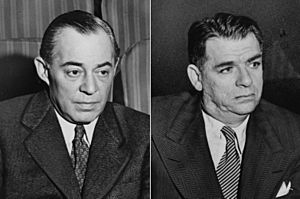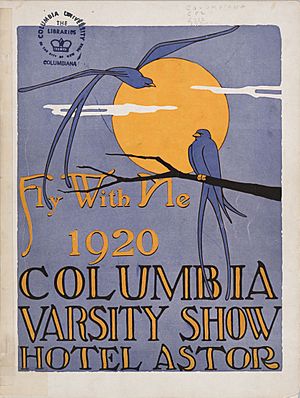Rodgers and Hammerstein facts for kids

Rodgers and Hammerstein was a famous team who wrote musicals for the theater. Richard Rodgers (1902–1979) wrote the music, and Oscar Hammerstein II (1895–1960) wrote the words (lyrics) and stories. Together, they created many new and important American musicals.
Their popular shows on Broadway in the 1940s and 1950s started what people call the "golden age" of musical theater. Five of their Broadway shows were huge hits: Oklahoma!, Carousel, South Pacific, The King and I, and The Sound of Music. Their television show Cinderella (1957) was also very successful.
They won many awards for their shows and movies, including thirty-four Tony Awards, fifteen Academy Awards, two Pulitzer Prizes (for Oklahoma! and South Pacific), and two Grammy Awards. Many people say their partnership was the greatest in musical theater in the 20th century.
Contents
How They Started Working Together
Rodgers and Hammerstein first worked together at Columbia University in 1920 on a show called Fly With Me. After that, they worked separately for a long time.
Rodgers worked with another writer named Lorenz Hart for over twenty years. They created many Broadway hits like Babes in Arms (1937) and Pal Joey (1940).
Hammerstein worked with other composers too. He teamed up with Jerome Kern on Sunny (1925). Their 1927 musical Show Boat is considered one of the best American musicals ever.
By the early 1940s, Rodgers' partner, Hart, was having personal problems and became unreliable. So, Rodgers asked Hammerstein if he would like to work together again.
Their Famous Musicals
Oklahoma!
Both Rodgers and Hammerstein wanted to create a musical based on a play called Green Grow the Lilacs. When their usual partners weren't available, Rodgers and Hammerstein decided to work together. The musical they created, Oklahoma! (1943), changed musical theater forever.
Oklahoma! was special because it used songs and dances to tell the story and develop the characters. The songs weren't just breaks from the story; they were a key part of it.
The show first opened in New Haven, Connecticut, and then came to Broadway on March 31, 1943. Unlike other musicals at the time, Oklahoma! didn't use big stars. The story and songs were the most important parts. It ran for a very long time, with 2,212 performances!
Many popular songs came from Oklahoma!, like "Oh, What a Beautiful Mornin'", "The Surrey with the Fringe on Top", and "People Will Say We're in Love". The show was so popular that its original cast recorded the music. This was the first time a musical had an original cast recording, which is now a common practice.
In 1955, Oklahoma! was made into a movie that won an Academy Award.
Carousel
Carousel opened on Broadway on April 19, 1945. It ran for 890 performances. This musical was also very new for its time. It was based on a play called Liliom and was one of the first musicals to have a sad story about a character who isn't a hero. It also had a long ballet dance that was important to the story.
Popular songs from Carousel include "If I Loved You", "June Is Bustin' Out All Over", and "You'll Never Walk Alone". A movie version of Carousel was made in 1956.
State Fair
In 1945, Rodgers and Hammerstein wrote songs and a script for a movie called State Fair. This was the only time they wrote music directly for a film. It was a big success, and they won their only Oscar together for the song "It Might as Well Be Spring".
The movie was remade in 1962. Later, in 1996, State Fair was finally turned into a Broadway musical.
South Pacific
South Pacific opened on Broadway on April 7, 1949, and played for over five years. Songs like "Bali Ha'i" and "Some Enchanted Evening" became very famous. The story is based on short stories by James A. Michener.
Rodgers and Hammerstein, along with co-writer Joshua Logan, won the Pulitzer Prize for Drama in 1950 for South Pacific. One song, "You've Got to Be Carefully Taught," was controversial because it talked about accepting people from different backgrounds. Rodgers and Hammerstein refused to remove it from the show.
The King and I
The King and I opened on Broadway on March 29, 1951. It tells the story of Anna Leonowens, a governess (teacher) who taught the children of the King of Siam in the 1860s.
The musical featured hit songs like "I Whistle a Happy Tune", "Getting to Know You", and "Shall We Dance?" Yul Brynner played the King and became very famous for the role, even winning an Oscar for the 1956 film version.
Cinderella
Rodgers and Hammerstein created their only musical specifically for television, based on the classic fairytale of Cinderella. It aired on March 31, 1957, on CBS. More than 107 million people watched it! Julie Andrews starred as Cinderella and was nominated for an Emmy Award.
The show featured beloved songs like "In My Own Little Corner" and "Impossible: It's Possible." Because it was so popular, new TV versions were made in 1965 and 1997. It finally came to Broadway as a stage musical in 2013.
Flower Drum Song
Flower Drum Song is based on a 1957 novel and takes place in San Francisco's Chinatown in the late 1950s. The story is about a young Chinese woman who comes to America hoping to marry a wealthy Chinese-American man. He is already in love with someone else, but his parents want him to marry the new immigrant.
This musical was a success and was important because it used a mostly Asian cast. A film version was made in 1961.
The Sound of Music
The Sound of Music was the last musical Rodgers and Hammerstein worked on together. It is based on the true story of the Austrian Von Trapp Family. It opened on Broadway on November 16, 1959, and was a big hit, winning many awards.
The show was made into a very popular film in 1965, starring Julie Andrews as Maria. It won five Oscars, including Best Picture. Hammerstein passed away in August 1960, before the film was made. So, when new songs were needed for the movie, Rodgers wrote both the music and the lyrics himself.
The Sound of Music has more famous songs than any other Rodgers and Hammerstein musical, such as the title song, "Do-Re-Mi", "My Favorite Things", and "Climb Ev'ry Mountain". "Edelweiss" was the very last song they wrote together.
Their Impact on Musicals
Rodgers and Hammerstein completely changed musical theater. Before them, many musicals were lighthearted or funny and often focused on a single star performer. Because Rodgers and Hammerstein's shows were so successful, many musicals that came after them started to have deeper stories with important themes. In their shows, all parts—the acting, dancing, singing, and drama—worked together as one complete story.
Many people, including famous composer Stephen Sondheim, say that Rodgers and Hammerstein greatly influenced their work.
Rodgers and Hammerstein also used a certain "formula" for their musicals. This often meant having a strong male singer (baritone), a delicate female singer (soprano), and supporting roles for a tenor and an alto. This made it easier for people to know what to expect vocally from their shows.
Their musical Oklahoma! was a huge turning point in theater history. Experts say that after Oklahoma!, Rodgers and Hammerstein were the most important people in creating the "musical-play" form, with masterpieces like Carousel, The King and I, and South Pacific. Their work encouraged other talented writers to create their own musical plays.
In 1999, the United States Postal Service honored them with a stamp. The Richard Rodgers Theatre in New York City is named after Rodgers.
On Television and Film
Rodgers and Hammerstein sometimes appeared on TV. They were guests on the very first broadcast of Toast of the Town (which later became The Ed Sullivan Show) in June 1948. In 1954, they were part of a special TV musical show called General Foods 25th Anniversary Show: A Salute to Rodgers and Hammerstein.
They also made a rare appearance in the 1953 movie Main Street to Broadway, where Rodgers played the piano and Hammerstein sang a song they had written.
Important Messages in Their Work
While Rodgers and Hammerstein's musicals often have happy and uplifting songs, they also bravely explored serious topics like racism and social class. For example, Carousel touches on domestic violence, and South Pacific deals with racism. The Sound of Music, based on a true story, shows how Austrians felt about the takeover of Austria by Nazi Germany.
Their Works
|
|
See also
 In Spanish: Rodgers y Hammerstein para niños
In Spanish: Rodgers y Hammerstein para niños
- Rodgers and Hart
- List of songwriter tandems


